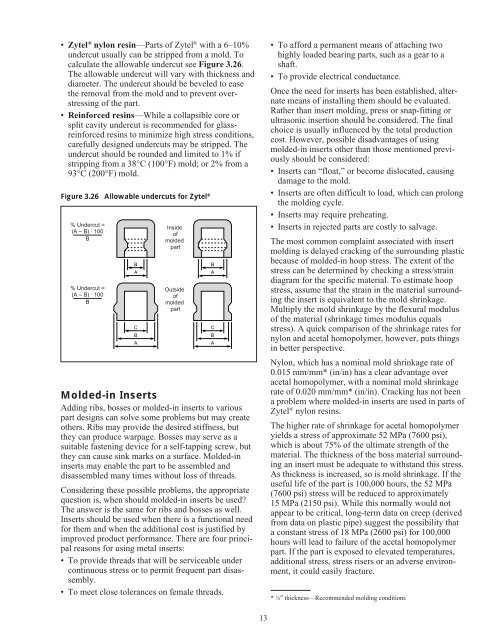General Design Principles for DuPont Engineering Polymers - Module
General Design Principles for DuPont Engineering Polymers - Module
General Design Principles for DuPont Engineering Polymers - Module
Create successful ePaper yourself
Turn your PDF publications into a flip-book with our unique Google optimized e-Paper software.
• Zytel ® nylon resin—Parts of Zytel ® with a 6–10%<br />
undercut usually can be stripped from a mold. To<br />
calculate the allowable undercut see Figure 3.26.<br />
The allowable undercut will vary with thickness and<br />
diameter. The undercut should be beveled to ease<br />
the removal from the mold and to prevent overstressing<br />
of the part.<br />
• Rein<strong>for</strong>ced resins—While a collapsible core or<br />
split cavity undercut is recommended <strong>for</strong> glassrein<strong>for</strong>ced<br />
resins to minimize high stress conditions,<br />
carefully designed undercuts may be stripped. The<br />
undercut should be rounded and limited to 1% if<br />
stripping from a 38°C (100°F) mold; or 2% from a<br />
93°C (200°F) mold.<br />
Figure 3.26 Allowable undercuts <strong>for</strong> Zytel ®<br />
% Undercut =<br />
(A – B) · 100<br />
B<br />
% Undercut =<br />
(A – B) · 100<br />
B<br />
B<br />
A<br />
C<br />
B<br />
A<br />
Inside<br />
of<br />
molded<br />
part<br />
Outside<br />
of<br />
molded<br />
part<br />
Molded-in Inserts<br />
Adding ribs, bosses or molded-in inserts to various<br />
part designs can solve some problems but may create<br />
others. Ribs may provide the desired stiffness, but<br />
they can produce warpage. Bosses may serve as a<br />
suitable fastening device <strong>for</strong> a self-tapping screw, but<br />
they can cause sink marks on a surface. Molded-in<br />
inserts may enable the part to be assembled and<br />
disassembled many times without loss of threads.<br />
Considering these possible problems, the appropriate<br />
question is, when should molded-in inserts be used?<br />
The answer is the same <strong>for</strong> ribs and bosses as well.<br />
Inserts should be used when there is a functional need<br />
<strong>for</strong> them and when the additional cost is justified by<br />
improved product per<strong>for</strong>mance. There are four principal<br />
reasons <strong>for</strong> using metal inserts:<br />
• To provide threads that will be serviceable under<br />
continuous stress or to permit frequent part disassembly.<br />
• To meet close tolerances on female threads.<br />
B<br />
A<br />
C<br />
B<br />
A<br />
13<br />
• To af<strong>for</strong>d a permanent means of attaching two<br />
highly loaded bearing parts, such as a gear to a<br />
shaft.<br />
• To provide electrical conductance.<br />
Once the need <strong>for</strong> inserts has been established, alternate<br />
means of installing them should be evaluated.<br />
Rather than insert molding, press or snap-fitting or<br />
ultrasonic insertion should be considered. The final<br />
choice is usually influenced by the total production<br />
cost. However, possible disadvantages of using<br />
molded-in inserts other than those mentioned previously<br />
should be considered:<br />
• Inserts can “float,” or become dislocated, causing<br />
damage to the mold.<br />
• Inserts are often difficult to load, which can prolong<br />
the molding cycle.<br />
• Inserts may require preheating.<br />
• Inserts in rejected parts are costly to salvage.<br />
The most common complaint associated with insert<br />
molding is delayed cracking of the surrounding plastic<br />
because of molded-in hoop stress. The extent of the<br />
stress can be determined by checking a stress/strain<br />
diagram <strong>for</strong> the specific material. To estimate hoop<br />
stress, assume that the strain in the material surrounding<br />
the insert is equivalent to the mold shrinkage.<br />
Multiply the mold shrinkage by the flexural modulus<br />
of the material (shrinkage times modulus equals<br />
stress). A quick comparison of the shrinkage rates <strong>for</strong><br />
nylon and acetal homopolymer, however, puts things<br />
in better perspective.<br />
Nylon, which has a nominal mold shrinkage rate of<br />
0.015 mm/mm* (in/in) has a clear advantage over<br />
acetal homopolymer, with a nominal mold shrinkage<br />
rate of 0.020 mm/mm* (in/in). Cracking has not been<br />
a problem where molded-in inserts are used in parts of<br />
Zytel ® nylon resins.<br />
The higher rate of shrinkage <strong>for</strong> acetal homopolymer<br />
yields a stress of approximate 52 MPa (7600 psi),<br />
which is about 75% of the ultimate strength of the<br />
material. The thickness of the boss material surrounding<br />
an insert must be adequate to withstand this stress.<br />
As thickness is increased, so is mold shrinkage. If the<br />
useful life of the part is 100,000 hours, the 52 MPa<br />
(7600 psi) stress will be reduced to approximately<br />
15 MPa (2150 psi). While this normally would not<br />
appear to be critical, long-term data on creep (derived<br />
from data on plastic pipe) suggest the possibility that<br />
a constant stress of 18 MPa (2600 psi) <strong>for</strong> 100,000<br />
hours will lead to failure of the acetal homopolymer<br />
part. If the part is exposed to elevated temperatures,<br />
additional stress, stress risers or an adverse environment,<br />
it could easily fracture.<br />
* 1 ⁄ 8″ thickness—Recommended molding conditions

















